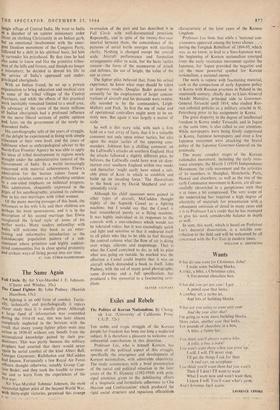Exiles and Rebels
THE noble and tragic struggle of the Korean people for freedom has been too long a neglected subject. It is therefore a pleasure to welcome any substantial contribution in this direction.
Professor Lee, who is himself Korean, has written of the political aspect of this struggle, specifically the emergence and development of Korean nationalism, with admirable objectivity. The study commences with a brief presentation of the social and political situation in the later yeaKs of the Yi Dynasty (1392-1910) with prin- cipal attention given to the debilitating effects of a 'dogmatic and formalistic adherence to Chu Hsi-ism and Confucianism' which produced the rigid social structure and rapacious officialdom
characteristic of the later years of the Korean kingdom.
Professor Lee finds that while a 'national con- sciousness appeared among the lower classes . . . during the Tonghak Rebellion' of 1894-95, which was, as we know, to lead to a Sino-Japanese war, the beginning of Korean nationalism emerged from the early resistance movement against the Japanese, for 'Japan provided the negative and yet the most powerful symbol for Korean nationalism, a national enemy.'
The work is replete with fascinating material, such as the comparison of early Japanese policy in Korea with Russian practices in Poland in the nineteenth century, chiefly due to 'Lieut.-General Akashi Motojiro, principal aide to Governor- General Terauchi until 1914, who studied Rus- sian colonial policies as a military attache in St. Petersburg prior to his assignment in Korea.
The great disparity in the degree of intellectual freedom in Korea under Terauchi, and in Japan at the same time, is also edited to our attention. While newspapers were being firmly suppressed in Korea, Japanese newspapers and even a few Japanese statesmen were attacking the brutal policy of the Japanese Governor-General on the peninsula.
The many complex stages of the Korean nationalist movement, including the early resis- tance attempts, the March 1 (1919) Independence Movement, the exile movement and the activities of its members in Shanghai, Manchuria, Paris, Hawaii and elsewhere, as well as the rise of the early Communist movement in Korea, are all suc- cessfully chronicled in a perspicuous style that is at times a bit compressed. The very scope of the undertaking has required a high degree of selectivity of materials for presentation with a subsequent omission of detail in many cases and it is to Professor Lee's credit that he has managed to give his work considerable balance in depth as well.
In sum, this work, which is based on, Professor' Lee's doctoral dissertation, is a notable con- tribution to the field and will be welcomed by all concerned with the Far East in modern times.
WILLIAM E. IIENTHORN




























 Previous page
Previous page